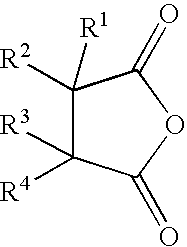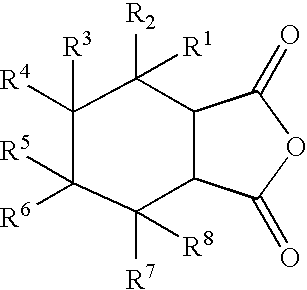Reactive carriers for polymer melt injection
a technology of reactive carriers and polymer melt, which is applied in the field of reactive carriers, can solve the problems of variable additive levels and inacceptable polymer molecular weight, and achieve the effect of reducing the molecular weight of polymer
- Summary
- Abstract
- Description
- Claims
- Application Information
AI Technical Summary
Benefits of technology
Problems solved by technology
Method used
Image
Examples
example 1
[0059]This example compares the preferred reactive liquid carrier of U.S. Pat. No. 6,569,991, polyethylene glycol (PEG), to that of the present invention.
[0060]A standard commercial polyester bottle resin (KoSa 3302, Spartanburg, S.C., USA) was used. PEG with a molecular weight of 400 was obtained from Union Carbide, Danbury Conn., USA. The cyclic anhydride was alkenyl succinic anhydrides (ASA), a mixture of alkenyl succinic anhydrides from Albemarle Corporation, Richmond, Va., U.S.A. that contains 54% hexadecenyl, 34% octadecenyl and 10% eicosodecenyl succinic anhydride
[0061]The 3302 resin was dried under vacuum at 150° C. for 12 hours. The dried resin was blended with the liquid carrier and injected molded into 48 gram preforms on an Arburg injection molding machine.
[0062]The preform IV was measured and the results set forth in Table 2.
[0063]
TABLE 2AdditiveAmount, ppmIVNoneNone0.743ASA2,0000.748ASA4,0000.741PEG2,0000.680PEG4,0000.625
[0064]These results illustrate that the ASA did ...
example 2
[0068]A mixture of ASA containing 5 wt.-% of a fumed silica, Cab-O-sil® M7D (Cabot Corporation, Boston Mass., USA) was prepared by stirring the fumed silica with the ASA liquid. Dried 3302 polyester resin was coated with this mixture by mixing in a bag, and then injected molded into 48 gram preforms on an Arburg injection molding machine. The level of ASA was 4,000 ppm (giving a fumed silica loading of 200 ppm). The coefficient of friction of the 3302 control was 9.3 compared to 0.2 with the anti-slip agent (fumed silica) incorporated into the resin with a cyclic anhydride.
example 3
[0069]The procedure of Example 2 was followed with a mixture of 81.2 wt-% ASA and 18.8 wt.-% of an UV absorber, Tinuvin 234 (Ciba Specialty Chemicals, Charlotte N.C., USA). The level of ASA was 4,000 ppm giving an UV absorber loading of 900 ppm.
[0070]The 24 gram preforms were blown into bottles (0.59 liter) on a Cincinnati Milacron stretch blow molding machine. The UV absorbance of the bottle side walls (0.38 mm) was measured. The % transmittance at 370 nm was less than 10% for the UV additive bottle compared to 80% for the 3302 control.
PUM
| Property | Measurement | Unit |
|---|---|---|
| boiling point | aaaaa | aaaaa |
| temperature | aaaaa | aaaaa |
| temperature | aaaaa | aaaaa |
Abstract
Description
Claims
Application Information
 Login to View More
Login to View More - R&D
- Intellectual Property
- Life Sciences
- Materials
- Tech Scout
- Unparalleled Data Quality
- Higher Quality Content
- 60% Fewer Hallucinations
Browse by: Latest US Patents, China's latest patents, Technical Efficacy Thesaurus, Application Domain, Technology Topic, Popular Technical Reports.
© 2025 PatSnap. All rights reserved.Legal|Privacy policy|Modern Slavery Act Transparency Statement|Sitemap|About US| Contact US: help@patsnap.com



